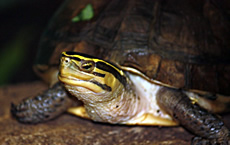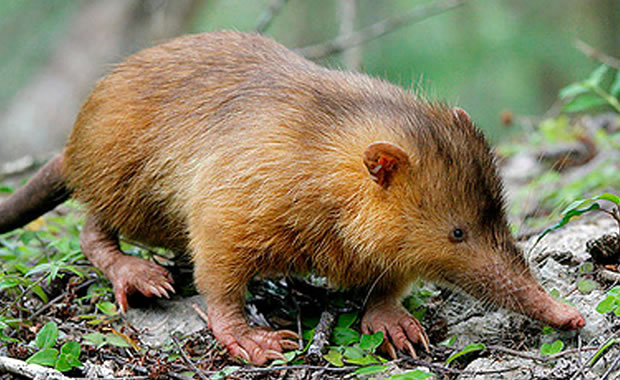

South Asian Box Turtle
|
Creature Profile
Also called the Amboina box turtle, the South Asian box turtle is a species of Asian box turtle found in the tropical rainforests of Southeast Asia. Unlike most box turtles, this turtle is extremely aquatic and prefers a warm and wet environment, only emerging from the water to bask or lay eggs. The box turtle gets its name from its ability to box itself up completely within its shell, allowing it to securely protect itself from predators. It can grow over 8 inches making it the largest of the Asian box turtles. The shell or (carapace) of this turtle is highly domed and dark olive to black in color, and the lower shell (plastron) is yellow to light brown, with large dark-brown/black patches toward the outside of the plate. Its head is small and olive to dark brown on top and yellow to olive underneath, and there are three distinctive black stripes running along the side. Males have longer and thicker tails than females, but they are smaller than females overall.
South Asian box turtles can be found in a variety of aquatic habitats including marshes, swamps, ponds, pools in streams, and flooded rice paddies. They are mainly nocturnal creatures and spend most of the day hiding under piles of leaf litter along banks of streams. Diet consists of aquatic plants, mollusks and crustaceans, fallen fruits, fungi and soft invertebrates, such as worms and slugs. They have been observed performing very interesting mating behavior, as males and females face each other with their necks outstretched, moving their heads in the shape of an infinity symbol. The male has been observed being very aggressive and chasing the female and biting her on her neck. During nesting, the female lays two to three eggs, and after the eggs are laid, the female does not provide any further parental care. After 67 to 77 days of incubation in the warn nest, the tiny hatchlings are born. South Asian box turtles can live up to 30 years.
The main threat to this species is over-collection for the food and pet trade. In some places, the species is hunted for use in folk medicine and in other places, the shells are collected and used as ornaments. The species is also threatened by habitat loss and degradation due to deforestation throughout much of its range. Since this species has been successfully bred in captivity and is not on the brink of extinction, it is listed as vulnerable with the IUCN.
Wikipedia Article

|
Wikipedia Article Copyright Notice: This article is licensed under the GNU Free Documentation License. It uses material from the Wikipedia article "Amboina box turtle". |
May 12, 2017
Glenn, C. R. 2006. "Earth's Endangered Creatures - South Asian Box Turtle Facts" (Online). Accessed 4/20/2024 at http://earthsendangered.com/profile.asp?sp=14231&ID=3.
Need more South Asian Box Turtle facts?




